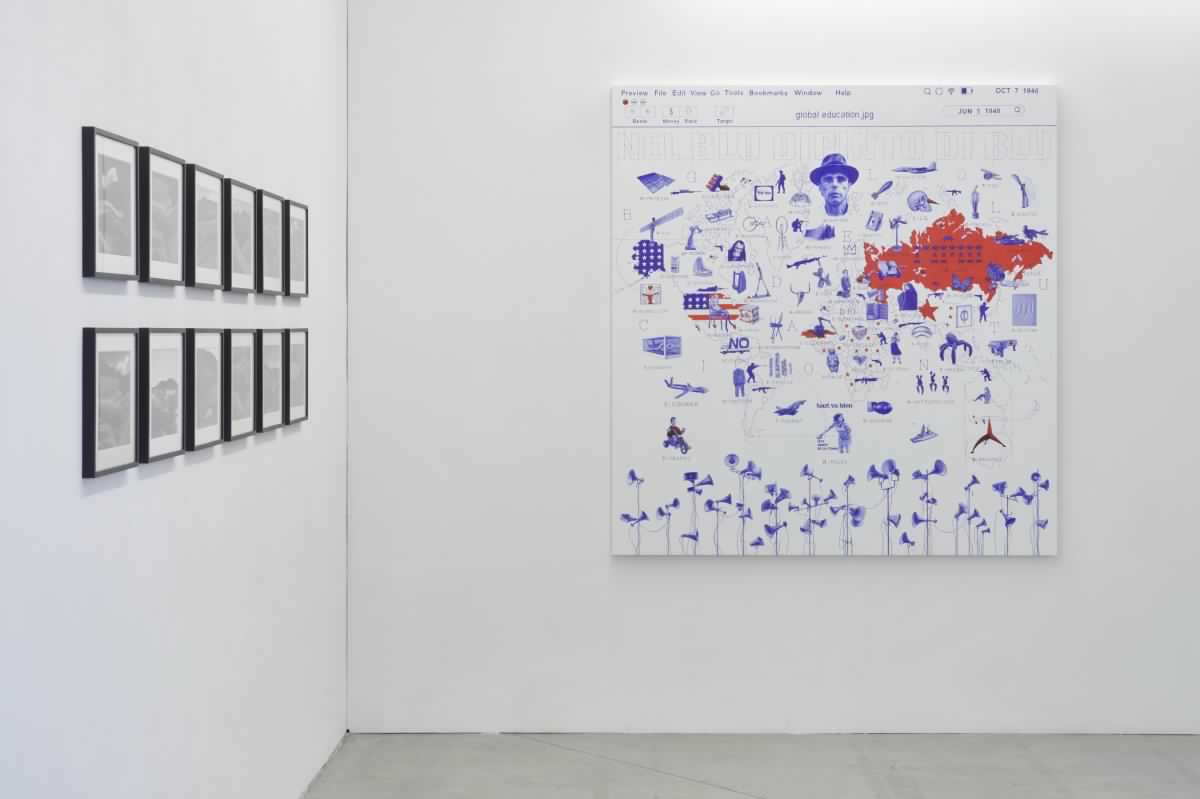Text by Francesca Guerisoli
29.03 – 21.04.2023
Via G. Ventura 6
20134 Milan
From Tuesday, March 28, 2023, the spaces of Prometeo Gallery Ida Pisani will welcome the latest works of the artist Giuseppe Stampone (b. 1974, Cluses) exhibited for the first time in the project Il cielo blu sopra il Gran Sasso / Campo Imperatore. The exhibition, subtitled From global to local for self-recovery offers itself to the eye as a hymn to joy, as Francesca Guerisoli points out in her accompanying text, which Stampone dedicates to the territory where he resides, where he works and where his family comes from. The new body of artworks, which includes two vinyls, three drawings and a bic pen Blue Stampone on board, a map, sixteen photographs and a video, expresses with great vitality an affection for the local dimension, rediscovered – in the need to stop dictated by the pandemic – as a space of identity.
The artworks exhibited are made in blue and black in equal percentage. As Guerisoli points out: “Stampone employs his blue for half of the works and black for the other half with a symbolic function capable of generating another point of observation of the context dear to him, which he reinterprets here in its aesthetic dimension. Blue and black thus become tools to bring to a ‘ground zero’ the image of Gran Sasso, by recasting it in its landscape and naturalistic value.”
Stampone charges his artistic narratives with a purely aesthetic vision that fixes images beyond their historical and cultural significance, giving wide space to the feminist dimension that belongs to the works resulting from his collaboration with Maria Crispal, artist and performer, his life partner. Thus, the video Gran Sassa is emblematic: while revealing the beauty and biological preciousness of the territory, it is transformed by a series of Crispal’s ritual actions into a sensual and poetic journey. However, Campo Imperatore is not only an enchanting mountain landscape but also one of the places that marked the History of Italy during World War II. Therefore, alongside with the naturalistic narrative, Stampone engages from a historical and cultural point of view by taking as a common denominator the Abruzzo folklore, which is put in direct connection with experimentation.
«Il cielo blu sopra il Gran Sasso / Campo Imperatore thus represents Stampone’s attempt to restore the complexity of that densely layered territory both from a naturalistic and panoramic point of view and from a historical and cultural one. The historical fact that made it known is wrapped up in the complexity defined through images. Campo Imperatore is the highest part that presents human interventions, it is the closest place to the sky».
Stampone touches the sky, and with his ink he restores, layer after layer, a visual and conceptual density that has an appendix centered on the wine culture that characterizes the area.
Testo di Francesca Guerisoli
29.03 – 21.04.2023
Via G. Ventura 6
20134 Milano
A partire da martedì 28 marzo 2023, gli spazi di Prometeo Gallery Ida Pisani accolgono gli ultimi lavori dell’artista Giuseppe Stampone (Cluses, 1974) esposti per la prima volta nel progetto Il cielo blu sopra il Gran Sasso / Campo Imperatore. La mostra, sottotitolata Dal global al local per il recupero di sé si offre allo sguardo come un inno alla gioia, come sottolinea Francesca Guerisoli nel suo scritto di accompagnamento, che Stampone dedica al territorio dove risiede, dove lavora e da cui proviene la sua famiglia. Il nuovo corpus di opere, comprensivo di due vinili, tre disegni e una tavola a penna bic Blu Stampone, una mappa, sedici fotografie e un video, esprime con grande vitalità l’affezione per la dimensione locale, riscoperta – nella necessità di fermarsi dettata dalla pandemia – come spazio identitario.
Le opere esposte sono realizzate in blu e in nero in eguale percentuale. Scrive a proposito Guerisoli: «Stampone investe il suo blu per metà delle opere e il nero per l’altra metà di una funzione simbolica capace di generare un altro punto di osservazione del contesto a lui caro che qui rilegge nella sua dimensione estetica. Il blu e il nero diventano strumenti per portare a un ‘grado zero’ l’immagine del Gran Sasso, rifondandola nel suo valore paesaggistico e naturalistico».
Stampone carica le sue narrazioni artistiche di una visione puramente estetica, che fissa le immagini al di là del loro significato storico e culturale, dando ampio spazio alla dimensione femminista che appartiene alle opere frutto della collaborazione con Maria Crispal, artista e performer, sua compagna di vita. Emblematico, in tal senso, è il video Gran Sassa che pur svelando la bellezza e la preziosità biologica del territorio è trasformato da una serie di azioni rituali di Crispal in un viaggio sensuale e poetico. Campo Imperatore però non è soltanto un paesaggio montano incantevole, ma è anche uno dei luoghi che hanno segnato la Storia d’Italia durante la Seconda Guerra Mondiale. E dunque, parallelamente al racconto naturalistico, Stampone si impegna dal punto di vista storico e culturale assumendo come denominatore comune la tradizione popolare abruzzese, che viene messa in collegamento diretto con la sperimentazione.
«Il cielo blu sopra il Gran Sasso / Campo Imperatore rappresenta dunque il tentativo di Stampone di restituire la complessità di quel territorio densamente stratificato sia da un punto di vista naturalistico e paesaggistico sia storico e culturale. Il fatto storico che lo ha reso noto viene avvolto dalla complessità definita sotto forma di immagini. Campo Imperatore è la parte più alta che presenta interventi umani, è il luogo più vicino al cielo».
Stampone tocca il cielo, e con il suo inchiostro restituisce, stratificazione dopo stratificazione, una densità visiva e concettuale che ha un’appendice centrata sulla cultura enologica che connota il territorio.
